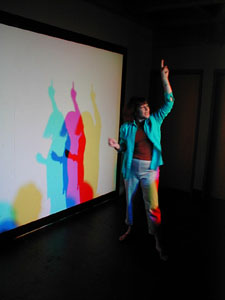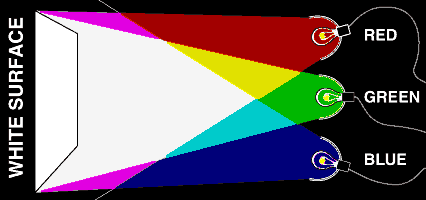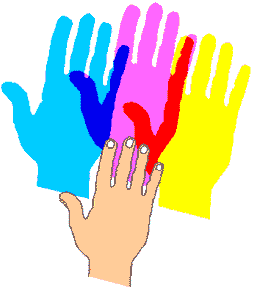
Linda Shore teaches about colored shadows.
Name the colors you see on the wall.

Linda Shore teaches about colored shadows.
Name the colors you see on the wall.
First build the Snack Colored Shadows
You will have a red a green and a blue floodlight illuminating a wall.

Just walk in front of the wall. Move back and forth, toward the wall and away from it. The play of colored shadows will act to draw in the viewers.
Exploration 1 Additive Colors.
Step away from the wall and look at it without any shadows.
Notice the color of the wall. It is whitish. It may have a color cast to it but it is definitely whitish. The human eye perceives the mixture of red light, green light and blue light to be white. (W = R+G+B)
(Aside, Other mixtures also appear white such as blue light and yellow light, or magenta light, cyan light, and yellow light, but for now we'll stick to red, green and blue.)(Aside What we have done is called additive color mixing. We add colors onto the white screen. There is another type of color mixing in which colors are removed, it is called subtractive color mixing. Mixing water color pigments, crayons, and paints produces subtractive color mixing.)
Turn off or block the blue light.
Notice that the screen looks yellow. Red light plus green light is perceived by the eye to be yellow light.(Y = R+G)
When we looked at the solar spectrum we saw a single wavelength of light that was also perceived as yellow light. Here the sum of lights of two different wavelengths also looks yellow. This is very important: two different mixtures of light can be perceived by the human eye to be the same color. You can see this at the Exploratorium Exhibit Seeing Yellow, (Seeing yellow is a difficult exhibit to reproduce outside the museum.)
Notice that red plus green produce yellow a color half way between red and green in the spectrum.
Next predict what color you will see when you block the red light.
You might predict that you will see cyan light, or blue green, half way between blue and green in the spectrum.
Block the red light and the screen becomes Cyan. (C = G+B)
So we seem to have the beginning of a pattern here.
Once more predict what will happen when you block the green light.
Perhaps you will predict that with the red and blue light shining on the wall you will see green light, half way between red and blue.
Block the green light and the wall is perceived to be magenta or purple, but not green! (M = R+B)
The eye perceives a mixture of red and blue as the color magenta, sometimes called purple.
Exploration 2 Shadows
Turn off the green and the blue lights. The wall will be red.
Step in front of the wall. Notice the black shadow where your body blocks the red light. Notice that you can draw a line from the light, to your body, to the shadow. Your body blocks the red light, it subtracts the red light from the wall in one region. The red light hits the rest of the wall unimpeded by your body.
I'm going to call the region of the wall where your red shadow is the minus-red region. -R
Do the same thing with the blue light on by itself to see the minus-blue region, -B
and with the green light on by itself to see the minus-geen region. -G
Turn on two lights, the red and the green.
Stand between the lights and the wall. Notice that the wall is yellow and that you have a red shadow and a green shadow.
Notice the red shadow is on the same side of your body as the red light.
There are two ways to look at what is going on:
The wall is red plus green making yellow, R+G=Y
So that where your body blocks green the wall is red, Y - G = R
Or, if you have an assistant put an eye in the red light region of the wall the eye will see only red light, the green light is blocked by your body. That's why the red shadow is on the red light side of the body!
Now turn on all three lights.
Notice that most of the wall is white, red plus green plus blue. W = R+G+B
Notice that you have a yellow shadow, a magenta shadow, and a cyan shadow! (You may have other shadow colors as well but let's study these first.)
Notice that the yellow shadow is located in the minus blue region. So that white light minus blue light is yellow light.( Y = W-B)
Have someone put one eye in the yellow shadow region and ask which lights they can see. They will see the red light and the green light. From the first exploration we know that red light plus green light is perceived to be yellow light. So we can look at yellow light as the additive mixture of red and green or as the subtraction of blue from white. Y = R+G = W-B
Similarly, cyan is white minus red, and magenta is
white minus green.
C = W - R, M = W - G
If you move closer to the wall, the magenta, cyan and yellow shadows will overlap and produce:

Blue and red shadows where shadows overlap.
The red shadow appears where your body blocks both green and blue. Have someone put an eye into the red shadow and ask them what color lights they see. They will see red only. So white light minus blue and minus green is red. W-B-G = R
Also white light minus green and minus red is blue. W -G -R = B. But red and green together is yellow, so white minus yellow is blue. W -Y = B. This is just the reverse of what we said above, white minus blue makes yellow. Color works both ways. (If W -X = Y then W-Y=X where W is white and X and Y are two other colors.) These other colors are known as complementary colors since they add to produce white. Solve to find W = X + Y.
Move your hand closer still and notice that a classic black shadow appears in the middle. Explain it.
Where your body blocks all three lights, no light reaches the screen. Put an eye in the shadow, it will see no lights. White minus red, minus green, minus blue is black. W - R - G - B = K (The symbol for black is K so it will not be confused with B for Blue!)
Etc.
There is a computer exploration of additive and subtractive color on the Exploratorium Website:
http://www.osc.on.ca/JustFun/InteractiveZone/AddCol/subcol.htmhttp://www.ontariosciencecentre.ca/scizone/games/subtracting/default.asp
You will need shockwave to run the above exploration.
http://www.exploratorium.edu/exhibits/mix_n_match/index.html
Red, Green, and Blue are chosen as the primary colors of additive light because the wavelengths of red, green, and blue can be added together to produce the largest number of colors. No other collection of three colors can produce as many colors!
Magenta, Cyan, and Yellow are chosen as the primaries of subtractive color because the largest number of colors can be made by combining pigments with these colors.
The additive colors add one color at a time, the subtractive colors subtract one color at a time. If red were a subtractive primary it would have to subtract both blue and green from white, this double subtraction leads to problems when adding red to other pigments.
|
Scientific Explorations with Paul Doherty |
|
22 May 2000 |